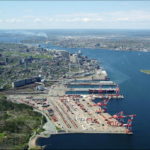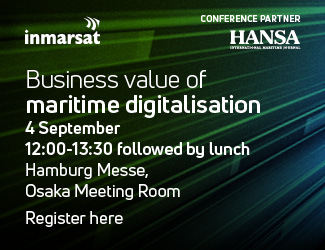The expanded Panama Canal and the liner shipping shakeup bring significant chances and challenges for North American ports. Canada’s existing and planned ports might see a future as transshipment hubs for the U.S..
The major ports on the U.S. East Coast serve local markets along with the vast hinterlands that lie to the[ds_preview] east of the »equal transportation cost line« described by transport expert Robert West (see sidebar) from the Columbia based consultancy Duaga. Along the East Coast of Canada, the local markets are smaller, and rail connections from the Maritime Provinces to the mid Continental hinterlands are more attenuated. However, a tantalizing opportunity may exist to trans-ship cargo to ports along the U.S. East Coast. Three ports could potentially be hubs, Sydney N.S., Halifax, N.S. and, possibly, St John N.B. for shipments down the coast.
Albert Barbusci, Principal at Harbor Port Development Partners (HPDP) – the consortium behind »Novaporte«, the potential deepwater mega terminal at Sydney, explained to HANSA that a new terminal at Sydney (with proximity to Europe on the Great Circle navigation route) could benefit from economies scale, with 80% of cargo trans-shipped to the U.S. East Coast and the balance sent by rail to Canadian markets including Montreal. The consortium behind HPDP, which would be privately funded, is impressive. It includes Canadian pension funds, the construction giant AECOM and the Asian behemoth Chinese Communication Construction Company (the parent of container crane maker ZPMC). Additionally, if the project moves ahead, the HPDP team will consist of port operator Ports America, and the global design/ engineer firm Stantec.
A tale of two hubs
The Port of Halifax, where the 10,000TEU »Zim Antwerp« called at the Halterm facility owned by a Macquarie Infrastructure Partners fund, is examining its potential as larger vessels become the norm. Late last year, the port began a strategic planning exercise, led by engineering stalwart Parsons Brinckerhoff, to prepare for the advent of larger vessels. A representative of the port told HANSA: »Infrastructure planning is well underway as we look at ways in which we can expand or develop the necessary pier length required to berth and service two vessels over 10,000TEU simultaneously. In partnership with key stakeholders, we are exploring various options to fully understand what is possible and how it can be developed in an efficient, cost effective manner.« The representative noted that: »We are looking for a solution that will serve the economy of the region well into the future.«
Where plans are on the drawing boards, as we can see in Eastern Canada, the catalyst for investors/ backers to pull the trigger is a commitment from a major carrier to call at a facility, an »anchor tenant«, in the parlance of property developers. So far, nobody has taken a bite at this apple. Mr. West from Duaga summarized the possible role for trans-shipping along the East Coast of Canada, saying: »From a high altitude perspective, the Canadian transshipment is a ‘parallel concept’ to the Caribbean transshipment triangle for Asian cargo shipped through Panama. One can imagine the Canadian ports serving North Atlantic US ports, shipped through Suez, and the Caribbean ports serving the South Atlantic ports and Mexico Gulf.«
Novaporte to rise with Cosco?
What needs to occur for trans-shipment to happen? With recent alignments of companies two amalgamations are worth watching. The first is the combination of Cosco and China Shipping Container Lines (CSCL), now called Cosco Shipping Lines. The merger dynamics caused the alliance profile to shift, the new company joined the Ocean Alliance (where CSCL had been a member), and quickly closed a deal which sees it gobbling up the parent of fellow alliance member Orient Overseas Container Lines (OOCL). Another Asian tie-up is the Ocean Network Express, or »ONE«, composed of three Japanese liner giants NYK, K Line and MOL.
Novaporte’s star may rise with Cosco’s might. Though it currently operates its Asia/USEC services through Panama, if Cosco were to be lured towards Suez (where its alliance partner CMA CGM already routes its vessels), the Canadian trans-ship option could take on real viability. In Halifax, multiple moving parts would need to fall into place. Ceres Terminals is wholly owned by ONE member NYK. The Japanese carriers are already transiting via Suez for 2 of 5 strings in their Asia/USEC services, would need to shift more capacity to Suez. If rumoured plans to move the Ceres Terminal (presently restricted by bridge heights), or Halterm, across the harbor to less congested-Dartmouth, actually coalesce, then deep drafted megaships could more readily call Halifax.
Barry Parker















